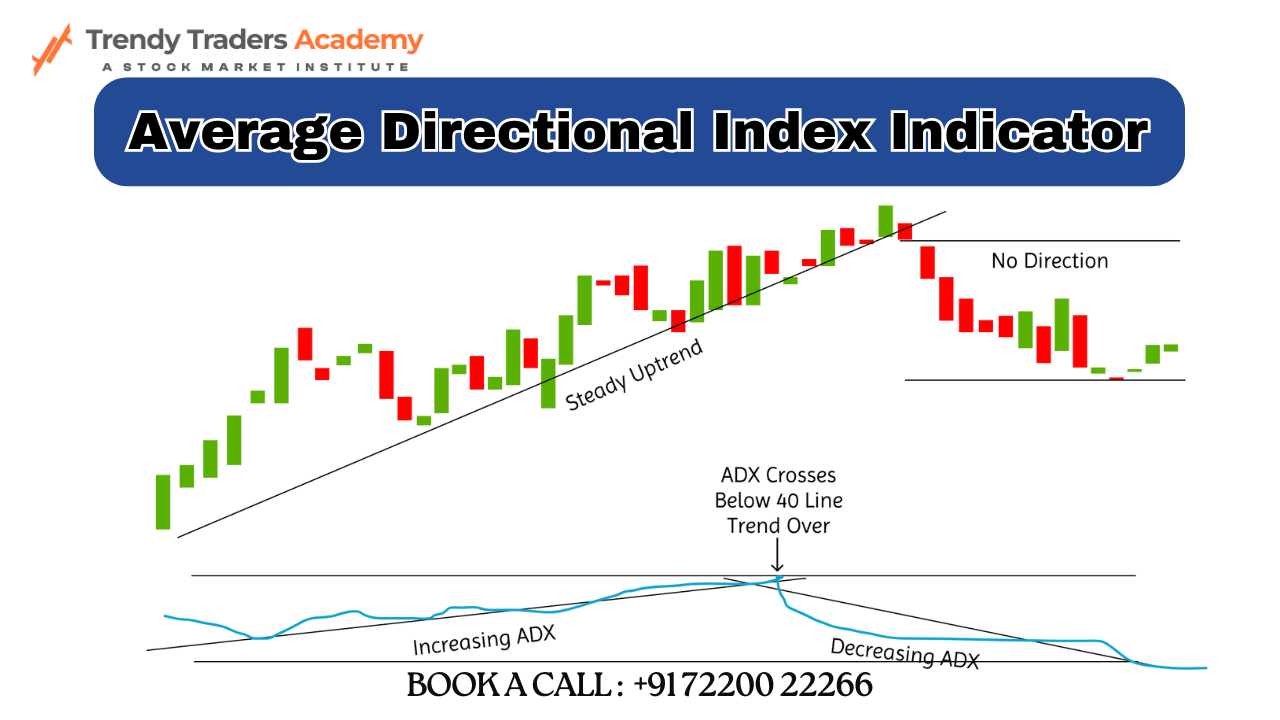Average Directional Index (ADX) Indicator: A Simple Guide for Everyone
Have you ever looked at a stock chart and felt like it was a puzzle only experts could solve? You’re not alone! The stock market can be a bit intimidating at first. But here's the good news — tools like the Average Directional Index (ADX) can make it a whole lot easier. Think of the ADX like a compass. It doesn’t tell you where the treasure is, but it shows you how strong the wind is blowing in a certain direction — up or down. That’s pretty helpful if you’re trying to sail the choppy seas of the stock market!
In this article, we’ll break down the ADX indicator in simple terms. If you're considering a stock market technical analysis course or browsing through courses stock market India, this is one concept you'll definitely want to understand.
Learn how the ADX indicator works in this beginner-friendly guide. Great for any stock market technical analysis course & courses stock market India.
What is the ADX Indicator?
The Average Directional Index (ADX) is a tool used by traders to measure the strength of a trend — not its direction. That’s key! Many people confuse the two. ADX just tells you if a trend is strong or weak.
Imagine you're trying to decide whether to join a marathon. Wouldn’t you want to know how fast everyone is running before jumping in? ADX gives you that insight in the market.
Why Should You Care About Trend Strength?
You know what they say: "The trend is your friend." But here’s the thing — not all trends are strong. Some are weak and short-lived. Knowing the strength of a trend can help you avoid jumping into a trade that fizzles out too quickly.
Whether you're into long-term investing or short-term trading, understanding trend strength helps you make more confident decisions.
The Components of ADX: DI+ and DI- Explained
The ADX is part of a bigger family. It comes bundled with DI+ (Positive Directional Indicator) and DI- (Negative Directional Indicator).
-
DI+ shows the strength of upward movement
-
DI- shows the strength of downward movement
When DI+ is above DI-, the trend is likely upward. And vice versa. The ADX sits in the middle, measuring how strong that move is.
How is the ADX Calculated (Without the Math Headache)?
Alright, deep breath — we won’t bore you with complex formulas.
Here’s the simplified version:
-
Measure price movement over a period (usually 14 days)
-
Compare upward vs. downward moves (DI+ and DI-)
-
Smooth it out to get a clean, readable line — that’s the ADX!
You don’t need to do the math yourself. Trading platforms calculate it for you. But knowing what goes on under the hood helps you trust it more.
Interpreting the ADX: What Do the Numbers Mean?
Here’s the golden cheat sheet:
-
0-20 = Weak or no trend
-
20-40 = Moderate trend
-
40-60 = Strong trend
-
60-100 = Very strong trend
So if the ADX is above 25, it’s telling you: “Hey, something is really moving here!”
ADX vs. Trend Direction: Clearing Up the Confusion
Let’s get this straight: ADX is neutral. It doesn’t care if the trend is going up or down. It only cares how strong that trend is.
You still need to look at the price chart or the DI+ and DI- lines to figure out which way the market is heading. Think of ADX like a volume knob — it tells you how loud the trend is playing, not the tune.
Real-Life Example: Reading an ADX on a Chart
Let’s say you're looking at Reliance Industries’ stock.
-
The price has been rising steadily.
-
DI+ is above DI-
-
ADX is climbing from 20 to 40
What does that tell you? A solid uptrend is gaining strength. That could be your cue to ride the wave — with proper risk management, of course!
Common Mistakes to Avoid When Using ADX
-
Assuming high ADX means price will rise: Nope! ADX only measures strength, not direction.
-
Using it alone: ADX is best when combined with other indicators.
-
Reacting too quickly: Wait for confirmation signals. Patience pays!
Best Settings for ADX: Default or Custom?
Most platforms use a 14-period ADX by default. And honestly, that works well for most people.
If you're a day trader, you might want a shorter period like 7 or 10. If you’re more into long-term investing, 20 or 30 could smooth out the noise. Try a few settings and see what suits your style.
ADX in Action: Day Trading vs. Swing Trading
-
Day Traders: Use ADX to spot quick bursts of strong momentum.
-
Swing Traders: Use it to confirm a trend before entering for several days or weeks.
Either way, it helps filter out the noise and gives clarity.
Combining ADX with Other Indicators
ADX is great, but it’s not a lone wolf.
Try pairing it with:
-
Moving Averages (to spot direction)
-
RSI (to check overbought/oversold conditions)
-
MACD (for entry/exit timing)
Together, they form a complete strategy that increases your win rate.
When Not to Use the ADX Indicator
ADX isn't much help in sideways markets or low-volume stocks. It may give false signals. Avoid relying on it when there’s no clear movement or during news-heavy trading days.
How ADX Helps in Stock Market Technical Analysis Courses
Most stock market technical analysis courses highlight ADX as a key topic. Why? Because it teaches you how to read the market’s mood. It’s a practical tool that beginners and pros can use.
If you're taking a course, look out for modules on trend analysis — ADX will be in there for sure.
Tools & Platforms That Offer ADX
You can find ADX on almost every trading platform:
-
Quanttrix
Just search for “ADX” under indicators, and you’re good to go.
Should You Learn ADX in Courses Stock Market India Offers?
Absolutely! If you're exploring courses stock market India, make sure they cover:
-
ADX basics
-
How to combine it with other tools
-
Real-time chart analysis
Courses like these make sure you're not just learning theory — but actually reading the market like a pro.
Conclusion: Is ADX Your Friend or Foe?
If used correctly, ADX can be your loyal ally in the market. It won’t make decisions for you, but it gives you a clear signal about whether the market is serious about its direction.
Like a weather forecast for traders, it tells you when to pack your umbrella or head for the hills. Pair it with the right strategy, and you’re set for smoother sailing.
FAQs
Is ADX better for beginners or experienced traders?
It works well for both! Beginners love its simplicity, while pros use it to fine-tune entries.
Can I use ADX for intraday trading?
Yes! Just adjust the period settings to something shorter, like 7 or 10.
How is ADX different from Moving Averages?
Moving Averages show trend direction; ADX shows trend strength. Together, they’re a powerful combo.
Should I rely solely on ADX for trading decisions?
Nope! Use it as one part of a larger trading strategy.
Do all stock market technical analysis courses in India teach ADX?
Most of them do — especially the comprehensive ones. Always check the curriculum before enrolling.



